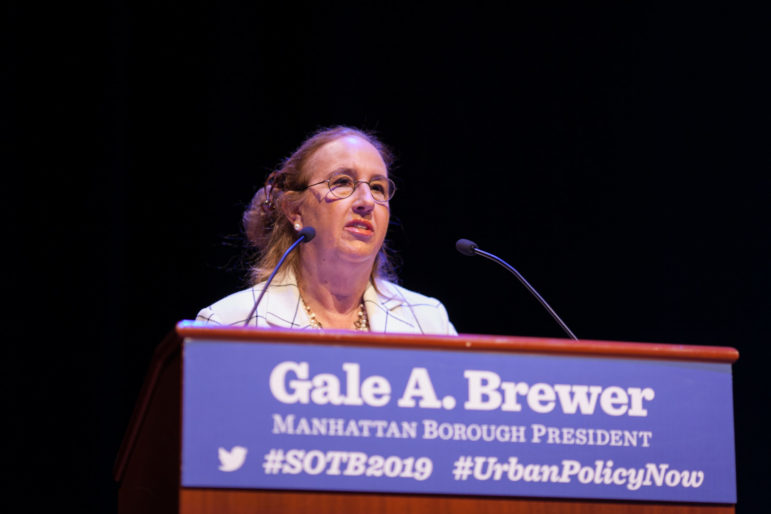
Office of the Manhattan Beep
Gale Brewer, Manhattan borough president since 2014, at her 2019 State of the Borough address.
A plan for four soaring skyscrapers on the Lower East Side. A bid to shore up NYCHA”s finances by constructing a massive new apartment building mixing market-rate and affordable units. A scheme to construct a hyper-tall building on Amsterdam Avenue.
What do those three things have in common? They all involve really big buildings. They all are located in Manhattan. And they are each the focus of a dispute between Manhattan Borough President Gale Brewer and the de Blasio administration.
Brewer has joined a suit to stop the administration from allowing the multi-tower Two Bridges projects to go forward without review under the city’s Uniform Land-Use Review Procedure (ULURP), a dispute that centers on the city’s controversial determination that the buildings represented only a “minor modification” of an existing land-use restriction on the site. She has also sued to stop the mayor from approving a 50-story building on the NYCHA Holmes Towers property without going through ULURP, even though the project runs counter to zoning rules covering the parcel. And she is pushing the Department of Buildings to respect a court ruling that indicated a project at 200 Amsterdam Avenue might was improperly approved by the Board of Standards and Appeals.
Defending ULURP
Appearing on the Max & Murphy Show on Wednesday, Brewer noted multiple areas where she’s working with City Hall on development and other land-use topics—like East Harlem, where meetings are underway to manage the 2017 rezoning, or East Midtown, where she sees progress under the recent rezoning there. Brewer is also working with the administration on discussions around a possible SoHo/NoHo rezoning.
When it comes to the Holmes Tower plan, however, Brewer’s disagreement with the mayor is about both process and policy.
“I understand the city needs money, but I’m a big believer in the Uniform Land Use Review Procedure, even on NYCHA land. We think the city is violating state public housing law, which requires review and approval by a governing body. That’s what it says, and that means ULURP,” she told the show.
“If in fact it did go through ULURP, its height and placement would not be allowed because it is too tall for that area. So the mayor used what we call mayoral override … but not a public process,” Brewer continued. She also raised questions about the financial elements of the proposal—namely whether the $25 million that NYCHA would earn from the developer reflects the site’s true value, especially when subsidies will flow the other way.
Of course, the ULURP process rarely leaves everyone happy – it certainly didn’t in the more recent Inwood rezoning. But Brewer argues it’s better than nothing. “I think in general ULURPs work. These rezonings are really tough but in the end you have—I wouldn’t say 100 percent buy-in—but you have some transparency. That’s not what you’re getting in Holmes and I’m afraid it’s not what you would get in similar situations.”
Tough NYCHA math
The beep also opposes the strategy behind the Homes Tower project, which is part of a larger push by the cash-strapped Housing Authority to capitalize on the value of some of its properties by leasing land for long-term, privately owned development, and then use those fees to address NYCHA’s $32 billion capital backlog.
Building 100 percent affordable new housing on NYCHA land, as the city is doing at several developments, eases the problem of intrusion somewhat—although such projects still can mean a reduction in open space, and can still create a disparity between the incomes of existing residents and new ones, because of the way affordable-housing is financed. Plus, 100-percent affordable projects generate less money for NYCHA to use elsewhere. “I think we need to find something – I don’t know exactly what it is – to deal with this situation at NYCHA. If you build affordable housing, you do get some money for the building. It’s not zero,” Brewer said. “But I do think that putting high-income housing on NYCHA land is problematic.”
Listen below as Brewer discusses her relationship with the mayor, her take on the charter-revision process and her outlook for 2021.








